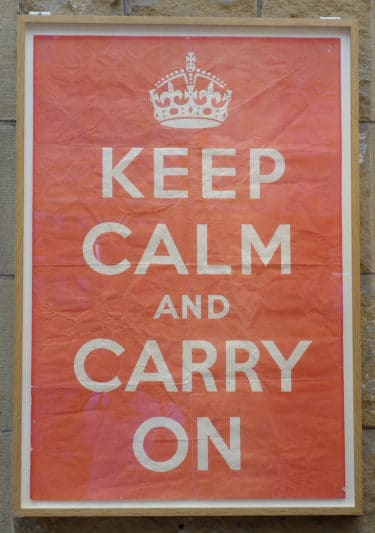It seems inevitable that any kind of looming crisis in Britain will bring with it mentions of the Second World War, the home front and that “Blitz spirit” which allowed people to “keep calm and carry on.” These nostalgia-tinged references evoke images of resilient and cheerful resourcefulness in the face of severe danger and deprivation. They encourage us to try to match the spirit displayed by past generations, to come together as a community and “do our bit” to overcome all obstacles without complaint or protest.
It’s no wonder that the idea of the Blitz spirit works in this way because this is what it was designed to achieve. In an effort to keep morale from crumbling due to the devastating effects of German bombing campaigns, the Ministry of Information worked with the media to create a particular kind of picture of how ordinary people were dusting themselves off and continuing their unified efforts, undaunted and defiant.
After the war ended, politicians of various stripes found it useful to build upon this collective pride in what was achieved, either as an admirable aspect of what it meant to be British or as a vision of class-levelling solidarity. Over the decades, even as popular material relating to the war has reached saturation point, certain aspects of the home front experience have received far more attention, while others have been downplayed or largely dropped from the public imagination.

in recent years, was never actually used during the war
Some things have even been resurrected that were never a feature to begin with; those Keep Calm and Carry On posters were not actually used during the war on the grounds that the message was uninspiring and could cause annoyance. Something which we could define as Blitz spirit certainly existed, in that there was a collection of feelings, impulses and incidents of kindness or selflessness which could collectively be given that label. But if we want to use the Blitz as an example of how to get through a crisis, we need to look behind the popular imagery to see the many complications and contradictions, and assess the limitations of that spirit.
War had been prepared for with increasing urgency from 1935, with teams of experts in a wide variety of subjects working on solutions to mitigate various anticipated crises in areas such as civil defence and food supply. The First World War had shown that patriotism, common sense and community spirit were not in themselves sufficient to overcome the effects of ingrained inequalities and self-interest on the home front and that far-reaching government intervention would be essential to surviving another global conflict. The Spanish Civil War also showed there would be an increased threat to civilians from aerial bombardment.

Re-organising and mobilising the full industrial and volunteer capacity of the UK towards the single purpose of winning the war was a huge, resource-heavy undertaking. Behind well-known slogans and initiatives such as “Dig for Victory” and the Women’s Land Army lay many thousands of hours of time given by public servants and volunteers, spent in unglamorous detail-oriented meetings of committees and sub-committees, without which nothing of use could have been achieved. An immense number of restrictions and regulations were imposed, reaching into every aspect of people’s lives, with harsh penalties for contravention. Nor was it taken for granted that people’s common sense alone would lead them to take the most useful or even the least damaging action; instead it was recognised that people needed not only ration books and rules to follow, but also practical assistance and advice. The tasks performed by (mostly) women to keep households going, including keeping people adequately fed, were recognised as essential war work and various national and local initiatives were devised to attempt to lessen this burden where possible.
Effective measures were at times hampered by a lack of understanding of what problems were faced by certain regions, professions, and in particular by the working class. Even though this was a war against fascist states, there were fears from some sections of government that the wrong kind of collective action and intervention could lead to a rise in radicalism and socialism. Plans for large underground shelters which could accommodate thousands of people were turned down partly on reasonable safety grounds but also due to fears that people might develop a “shelter mentality” and refuse to go about their normal lives. There were also concerns about disruption to the family unit and to the role of women in family life. When “British Restaurants” – self-service canteens providing basic meals on a non-profit basis – were established from autumn 1940, it was assumed that these should not be open on Sundays to preserve the tradition of families sitting down to a Sunday roast, even though this was something that many working-class families could not afford to make a tradition.
Entrenched class divisions had already become a problem during earlier evacuation schemes as wealthier families could move to the country, build garden shelters or even send their children abroad, while poorer families had to take their chances in unsanitary and poorly-built public shelters or hope that their children would find kind, supportive hosts elsewhere.
The Blitz itself began September 1940 and over 1,000 civilians were dead by the end of the third night of bombing. While people were literally brought closer together in whatever official and unofficial shelters were available, and newspaper and radio reports emphasised Londoners’ resilience and generosity, there was nevertheless widespread dissatisfaction with the obvious disparities between wealthier and poorer areas. Entrenched class divisions had already become a problem during earlier evacuation schemes as it was seen that wealthier families could move to the country, build garden shelters or even send their children abroad while poorer families, who were more likely to live in the worst-hit areas, had to take their chances in unsanitary and poorly-built public shelters or hope that their children would find kind, supportive hosts elsewhere. There were campaigns and sit-in protests regarding access to private basements and underground stations. Push-back against misguided or inadequate planning, and organisation at a community level to plug gaps in support, were essential to London’s ability to function.
There are many things to be wary of when invoking the home front and the Blitz as an example applicable to current events. Crisis planning requires careful thought and consultation and part of this means listening to opposition and complaint and understanding the real problems which hinder compliance. It’s important to understand that the impressions we have are not simply remembered or recorded slivers of reality but were created and shaped with a particular purpose – the media at the time were not free to report in ways which might undermine morale or the war effort.
It’s also worth bearing in mind that war has the ability to channel people’s anger and resentment against a defined enemy, as well as mobilising more positive drives. The Blitz spirit, to the extent that it existed at all, did not arise spontaneously and fully-formed in response to adversity, nor was it sustained over many months without cultivation.
If we ignore the enormous effort of planning and preparation, the hardships people suffered, the freedoms and comforts they sacrificed, or the huge number of people who did not live to see the end of the war, we do a great disservice to what was achieved on Britain’s home front, and miss anything truly useful we can learn from it.



